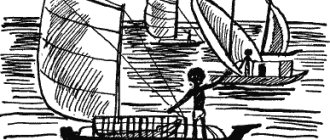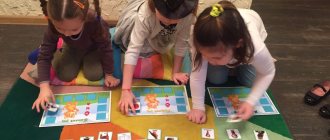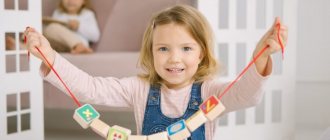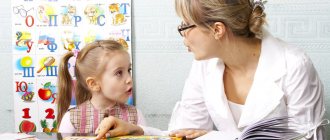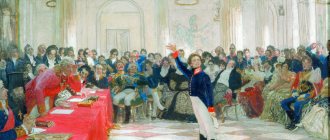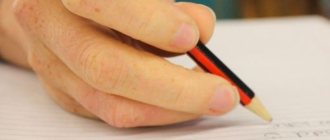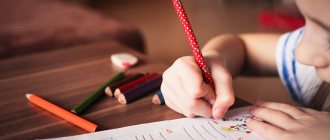Best age
So, experts are sure that teaching the science of reading should begin in preschool age. At school, a child will encounter many innovations, first of all, his main activity will change, and he will unexpectedly move from playing to learning. It is not simple. You have to sit at your desk for a long time, concentrate on what the teacher is talking about, learn to communicate with previously unfamiliar peers, and look for your place in society.
The student becomes more independent, he now needs to behave in a disciplined manner, become familiar with arithmetic operations, learn to draw, make crafts, and so on. Therefore, acquiring another new skill - reading - will cost a lot of effort. And those parents who feel sorry for the child, do not want to read with him, strive to extend his childhood by at least a year, are actually doing him a disservice - time is wasted, their child will have to study hard and intensely at school.
It’s better to start at 4.5-5 years old. At this time, the child is able to concentrate for about 10 minutes , this is quite enough for learning. You can learn letters earlier - at 3-4 years old, the baby has all the reserves to become familiar with the alphabet and gradually memorize letters.
In your baby's room you should hang a beautiful, bright poster with letters on it. Gradually they will be deposited in the head thanks to passive memory and become recognizable.
It would be useful to let a child of 3-4 years old play with cubes, on the edges of which letters are written and an object is drawn, the name of which begins with each of them (for example, K and cat). As the child builds a fort out of cubes, during the game he will gradually remember what the letters look like and what they mean.
It is equally important to form a sustainable interest in the book. Parents of preschoolers have a great responsibility: if they force their child to read, yell at him, and get nervous, then there is a high risk that the child will forever be disappointed in reading and even in adulthood will be extremely reluctant to open a book. This can be avoided if you regularly praise him, and the process itself, despite its seriousness, is transformed into an exciting game.
Is it possible to quickly teach a child to read?
You can teach a child to read quickly only with systematic lessons. It is recommended to study with your baby at the same time. The duration of classes is 10-15 minutes. When the baby learns to form syllables, classes are gradually increased to 30 minutes.
Reading should be combined with other activities. The child is asked to color the letter he has learned and write a printed version. Thus, the baby not only works on memorization, but also develops small muscles in the hand, which contributes to faster learning to write. The picture should be large, the illustration should not distract from the letter, it should contain the ability to circle the letter along the dotted line and write it on the line.
You can also reinforce the learned material using letter cubes. “Smart Cubes” with a writing simulator are ideal for this purpose. The child will not only mechanically connect letters into syllables, pronounce the resulting combinations, compose words and sentences, but also trace the contours of each letter in a stencil.
Basic techniques
There are several methods that allow you to teach a child to read; we present the pros and cons of each of them in the form of a table.
| Method name | Short description | Advantages | Flaws |
| Sound (phonetic) | Children learn to pronounce words and sounds and begin reading when they remember enough phonemes to read their first words. | Used at school, so the baby will be saved from having to relearn. Eliminates speech defects, teaches you not only to read correctly, but also to pronounce words. You can exercise anytime, anywhere. | Requires a long time, training will be long. At first, the baby will be so focused on the process of correctly pronouncing phonemes that he will not understand the meaning of what he read. |
| Zaitsev cubes | Learning to read by sequences (a sequence is the pair “consonant + vowel, or consonant + b, b). | Learning through games will be fun for both children and adults. The child learns to read quickly, with joy, and does not suffer from performing a boring and obscure action. The system is not tied to a specific age; it can be used at least one year old, at least 5-6 years old. | At school, children will be retrained, since they will teach phonemic analysis of a word, and not dividing it into words. Some problems may arise with the letter E: on the cubes there are many variants such as “BE”, “DE”, but in the Russian language there are very few words of this kind. |
| Doman cards | Recognition of a whole word - without dividing it into component parts. Rather, not reading, but memorizing and reproducing. The child quickly makes progress thanks to his amazingly flexible memory, and gradually he develops an understanding of the principles of reading a particular group of letters. | Memory development, the ability to teach reading from an early age. | Preliminary preparation is required (make a lot of neat cards), regularity of classes. Cards with specific words should be shown to the baby several times a day, taking into account his individual pace of perception of information. Often children taught in this way learn to read situationally, unable to read, for example, a familiar word, but printed in a different font. |
| Maria Montessori Method | First, children learn to write (frames-contours are used for this), only after that they become familiar with letters. | The classes are fun and not boring, children learn to read and write at the same time, and during the reading process they do not divide the word into syllables, reading it completely. The activities also help develop fine motor skills. | The technique is intended for work in a kindergarten group, and not at home. You will need a large amount of didactic material that will have to be purchased. |
| Olga Soboleva's program | It is built according to the method of letter recognition and is aimed at the creative development of the baby. There is practically no mechanical memorization; the work is based on associations. | Children have fun and learn to love reading. The technique helps you learn a lot of new words and not give in to a new type of activity, and feel free to use a creative approach. | Suitable for creative kids and their equally creative parents. There is no clear description of what should be done and how, so you need to use your imagination. |
Each of the considered methods has both pros and cons, so parents will have to choose the elements of each of them that best suit the characteristics of their baby, and use them in daily, targeted work. There are several interesting activities that parents can use at different stages of learning to read.
Primer N.S. Zhukova
Using Zhukova's ABC book, it will be easy for parents to teach their child to read syllable by syllable. The content of the book is simple and understandable. It has additional tips and notes on every page. They will help parents pay attention to difficult moments in learning, and explain in more detail to the child what is not clear.
The pages are designed so that the letter catches the eye. Each sheet contains illustrations that will interest the baby. To make it easier for him to learn to read syllables, there is a wavy line between the letters, and a running man above it.
You can buy the primer at any bookstore.
How to determine that a child is ready to learn?
Psychology has developed a number of physiological signs that indicate a child’s readiness to learn to read:
- The child pronounces sentences and speaks freely. Children who were taught to read with blocks before they could speak had delays in speech development.
- The child has developed phonemic hearing: the baby hears individual sounds in words and knows how to separate them from neighboring ones, knows what sounds are included in a word, can easily select a number of words starting, for example, with the letter N and ending with the letter A, or identify a common sound in the words “midge, tire, cat.”
- The child does not have serious speech therapy problems, for example, the baby is not able to pronounce half the alphabet normally, which significantly impairs phonemic hearing and prevents him from reading correctly.
- The child is well oriented in space, for example, he knows where the left side is and where the right side is. Knowing how to navigate correctly is very important, since the child will have to read words from left to right. If the orientation is disturbed, children may, for example, begin to read a word with any letter, confuse the bottom and the top (for example, b and p).
Typically, all of the above signs appear in children by the age of five.
Age-related characteristics of the perception of letters and sounds
The child masters the sounds of the world and tries to pronounce them from birth.
- The baby begins to “boom”, speaking his own language with his mother. As he falls asleep, he seems to be singing, repeating his mother’s motion sickness, rocking himself to sleep.
- As he grows up, he begins to repeat the sounds that begin words that define the actions and characters he understands.
- By the age of one year, the little man already quite clearly says “mom”, “dad”, “give”, “na” and similar words. He knows the names of his toys, actions related to feeding, bathing, sleeping, dressing. But I am not yet able to speak such complex words.
- By the age of two, a child usually already clearly speaks not only words, but also phrases. While not yet pronouncing all the sounds, he can say: “let’s go for a walk,” “let me eat,” “I want to sleep.” During this period, it is quite possible to begin learning letters using pictures or cubes. He already knows the sounds and can put them into words in oral speech. And this is a signal that it is possible to show how these sounds look in written speech.
It is necessary to start with images that are familiar to him: a car, a horse, a scoop, a plate, an apple, snow, a window... For clarity, you can lay out the letter C from snow, and assemble an M from cars. He will begin to remember what a specific letter looks like, what object or action she matches. Of course, the whole word is still inaccessible to him at this time.
It is appropriate to use not only cubes with letters and pictures. It’s great that the child can clearly see on the cube that each letter corresponds to a specific picture:
- machine - M
- Yula - Yu
- blade - L
- sled - C
But you shouldn’t neglect book illustrations. Firstly, the child will immediately be able to perceive the analogy between letters and a printed book.
It is very important to instill interest in a paper publication that contains familiar characters. If you get your child interested in learning the graphic names of objects from drawings in a playful way, then further learning to read will be easier.
When to start teaching your child to read
A child’s acquaintance with the alphabet happens very early, but how to teach a child to read and write from scratch correctly? By the age of 2-3 years, many toddlers recognize and name some letters. The ones that are easiest for them are those that represent vowel sounds. These are A, O, U, I. They are easy to pronounce, sing, draw, or lay out from sticks or strings. If things go well, then gradually, one by one, you can add consonants
It is important to choose the right ones that are formed first in the baby and are easy for him to pronounce. M, P, B, D, T will help add the first syllables.
The main rule for home school: sound and letter are different concepts. If you want to teach your child to read correctly, then tell him not the letter, but the sound it stands for: “B”, not “Be”, “P” - not “Pe”. Only in this case will the baby be able to easily combine them into pairs, i.e. syllables. If this stage was successful, then your little student will read “PA” and “MA”, and not “PeA” or “MeA”.
There is no need to rush and demand that your child memorize all the letters of the alphabet; by the age of 3, learn to read any words quickly. At this age, you need to create a good foundation for mastering fluent reading in the future. The best way to learn, of course, is through play.
Games to help you learn letters:
I'll call you, and you show me
The adult pronounces the sound, and the baby finds it on a card or wall alphabet.
The letter hid
In a small bag, the child is asked to find the desired three-dimensional letter-figure. It’s more interesting to play if you can’t spy and complete the task only by touch.
The sounds have become friends
All the letters that the child has already become familiar with are attached to toys (figurines, cars, cubes) and connected two at a time, in random order, with consonant and vowel sounds. You need to correctly read the resulting syllable. Then the objects are swapped and the task is repeated. Be sure to praise your child for his successes and rejoice at his first victories. You shouldn’t blame yourself for mistakes; there is still plenty of time to correct them.
Getting ready for school
For a 4-6 year old child, a new, very important stage begins - preparation for school and training. The ABCs and basics of literacy should already be mastered by this time. The time has come to get acquainted with the vowels of the “second row”, which denote two sounds at once - I, Yu, E. The future student learns to quickly distinguish paired consonant sounds K-G, P-B, V-F. Learns that sound can sometimes be soft and sometimes hard.
These rules and training in their application help not only to learn how to easily read texts in the alphabet and children's books, but also to prepare for writing. Literacy is a good visual memory and excellent phonemic awareness, i.e. the ability to hear and recognize all the sounds in a word.
Learning algorithm
Teaching a child to read coherently is not as simple as it might seem at first glance. This is a rather serious matter that requires patience, perseverance and some preparation by the parents themselves. The process of developing reading skills consists of three steps:
- learning letters and their corresponding sounds;
- folding letters into syllables and practical training in reading them;
- putting syllables into words and practicing continuous reading.
Bakhtina's method is suitable for very young children who are barely 2 years old. The author assures that children who regularly study at home using her method can read well by the age of three. According to Zhukova’s ABC book, children study at school, i.e. at the age of 5-6 years.
General principles of training
If you don’t know how to teach a child to read correctly, be guided in the learning process by the following basic principles developed by child psychologists:
- First you need to teach the child hard open vowels, such as A, O, Y, E, U, and then voiced hard consonants: L, M. In this case, consonants can only be pronounced with sounds (not EM, but simply “M”). After which you can move on to studying hissing and dull sounds: Ш, Ж, Д, Т, К and others.
- At each lesson, it is imperative to repeat the material covered in the previous lesson, that is, those sounds that were studied earlier. This technique of consolidating material is called “repetition is the mother of learning” and will help the child develop the correct reading technique much faster.
- You can move on to reading syllables only after a thorough study of some of the sounds. You need to start with simple syllables, such as LA, MA, PA.
- After studying the syllables, you can move on to the first simple words: MA-MA, MO-LO-KO.
- To teach a child to read correctly, it is necessary to monitor the pronunciation of syllables: there must be pauses between words, and even more so, between different sentences and phrases.
Is the child ready to learn?
Before starting the process itself, it is necessary to take into account the child’s psychological and physical readiness for learning. There are several basic criteria by which you can determine in what key to start, so that learning does not subsequently turn your preschooler away from reading for the rest of his life.
- If your child speaks fluently in sentences and connects phrases logically, then it’s time. Check to see if your son or daughter understands what you read.
- An important criterion is the ability to distinguish sounds. Speech therapists call this phonemic awareness. For example, mushroom - flu, soup - tooth, mouth - genus. Does the child understand that these words have different meanings?
- A big problem on the path to learning can be a speech delay or incorrect pronunciation of certain sounds: if a child pronounces sounds incorrectly, then the help of a speech therapist is required. Don't expect the problem to solve itself. Take your child to classes with a specialist and attend them regularly, and also be sure to complete the tasks that the teacher gives you to independently reinforce the educational material. Speech delay, stuttering - it is necessary to show the child to a neurologist and psychiatrist. In any case, there is a reason, and it needs to be found out.
You might be interested in How to teach children to speak - a detailed action plan for parents
- You should definitely teach your child where left and right are, up and down. This will help him navigate the text: which side to start reading the word from, where is the top line and where is the bottom.
Getting to know sounds
Before you get acquainted with the appearance of the letters, tell your child about the sounds. Divide them into several groups. For example, vowels - they can be sung, voiced sounds - show them using the example of sounds of nature (thunder rumbles, a tiger growls), unvoiced ones relate to quiet, non-melodic sounds (shhhh, puff).
At this stage, it is important to form an image, a phonetic shell of letters.
This will help the child perform syllabic and phonemic analysis of words at school.
On a note! To distinguish between voiced and deaf when speaking, use your fingers to your throat. When pronouncing R, D, M and other voiced consonants, there will be vibration under the fingers. When pronouncing deaf words (SH, P, S, etc.) there is no vibration.
"Catch the Sound"
We tell the child words, and he should clap his hands when he hears a certain sound (for example, [l]).
Learning and remembering letters
Start getting acquainted with letters by setting goals. Explain why you need to know this. Tell us about the possibilities that the book opens up, about writing, the culture of different peoples. The main task is to interest the baby.
Continue the motivation with simple examples of letters. Start with vowels, for example A, U. The kindergartener will quickly remember them, learn to write, and be able to read the first word: AU!!! When he realizes that reading is not difficult at all, the lessons can be entertaining and fun, move on. Combine new letters with adding syllables and simple words.
Another option for learning about letters is studying with reference to a picture. For this you need primers or ABCs. M - cars, T - cake, V - crow, etc. This method is necessary for visual children. To quickly memorize symbols and write the alphabet, use modeling, coloring letters, and tracing them in copybooks.
"Live Letters"
Seeing and reading letters is interesting, picking up letters is even more interesting! Don't limit yourself to cards and cubes, create letters together with your child: sculpt them from plasticine, cut them out of paper, lay out cookie letters from dough.
Letter learning games
- Puzzles. Assembling letters from parts. Make the puzzles yourself and cut them into large pieces or buy teaching material at the store.
- Memory. Write down the letters on small pieces of paper. Lay out the cards on the table. Let the baby remember, then turn it over. Let him look for the desired letter according to the model.
- We write on sand and semolina. Attaching letters on loose material trains memory and motor skills at the same time.
Board games
Cards with letters, syllables and words are entertaining, but children are even more captivated by educational board games for reading, which are fun to play in a group. For starters, you can consider board games such as “Animal Letters” and “Read-Grab.”
"Fisherman"
You will need fish with paper letters, each with a paper clip attached. You need to catch fish with a fishing rod (with a magnet on it), name the letters on them, and put them in a bucket. You can ask your child to name words that begin with these letters. Later, you can make syllables from these letters - and pronounce them too.
"Secret Letters"
Try writing letters to your child in the name of his favorite character or toy so that he will want to answer them. You can purchase ready-made materials for such letters at the bookstore.
Example: notebook “I will teach you to read” with letters from the gnome Gosha.
Learning by playing
Playful learning to read is perhaps the most enjoyable and accessible method for children. The name itself speaks for itself - the child actively masters knowledge, while doing what he loves to do.
Let's take, for example, this simple game. Here is a letter in front of the baby - it can be drawn, made from paper, sewn from fabric, even molded from plasticine (another plus is the development of fine motor skills), and here is the second one - and they catch up with each other.
You can play “search for lost letters” for those who are lost and cannot find their way home. How can I help them? Name it correctly. The letter "A" will be read and "go home", and so on. Involve your child in this simple game - look for the necessary letters in television programs, picture books, on the street in store signs, and so on... There are a lot of options.
You can make a “Letter Maze” at home. Take cardboard and make cards of the same color and size, write letters on them. Let the vowels be red and the consonants blue. This will make it easier for the baby to remember them. And now make a hole in each card and stretch a thread through this hole at different distances. Place a string with letters strung on it around the apartment. And let the child find the beginning of this string and move forward along it, naming each letter he encounters. Both interesting and simple!
On the one hand, this method seems to have only one advantage - after all, it’s good for the child, it’s not boring, and it’s easy for mom and dad - the games are not complicated, and the skills gained with their help are very valuable. But there are still some disadvantages. Namely, any activity can become a game... That is, the child will get used to only playing, and when real serious activities begin, he will perceive them incorrectly
Therefore, you should immediately set priorities, because your goal is not only to play, but also to teach reading, the ability to focus attention, and be assiduous
After you master the letters in the game, in the same way you can start learning syllables, and then reading simple words. Another important point! No matter how interesting your game is, always pronounce the readable letters, syllables and words correctly. There is no need to distort the correct accent, watch yourself and your child. The game-based method of teaching reading by syllables involves a funny presentation of information, entertaining lessons, but not baby talk or inventing stupid diminutive words.
Adding the syllables
Your baby has learned to combine two vowels and can easily read AU and IA. Move on to merging vowels and consonants. First teach to read open syllables, then closed ones. Make the first words from identical combinations: MA-MA, BA-BA. Use the reverse options: AH, UM, AM, OH.
Show how to sing the syllables. Focus on the fact that the sounds run after each other. This is well shown in the ABC of Nadezhda Zhukova. After this, you can connect several syllables together and put another consonant between them: ZHU-CH-KA.
The easiest way to automate reading by syllables is syllable tables. These are cards with columns of syllables. If you read them daily, gradually accelerating the pace, the child will easily recognize them in words. We advise you to print out syllables for teaching children to read on sheets of paper and give one option per lesson.
How syllable tables can help and how to use them
Syllable tables are an excellent way to learn. These are special sets that consist of syllables repeated several times in a row. A striking example is the following plate:
Syllable table
The advantage of this technique is that pronouncing syllables perfectly trains the child’s articulatory apparatus. To begin with, all syllables are pronounced at a slow pace, then it gradually speeds up. The result is a kind of tongue twister that is pronounced “in one breath.”
Thanks to such activities, speech motor skills are significantly improved and oratory abilities are developed. Of course, it will be difficult for the child at first, so you should not expect lightning-fast results.
Important! All classes should be based on the principle of a game - this way learning new things will be easier, more interesting, and more fun.
You can recite no more than 3 lines in one lesson. If it’s difficult for a child, then you need to stop at line 1, but study it thoroughly. Otherwise, there will be no effect from the classes.
Open syllables can be read in two directions - diagonally or vertically. The consonant sound must be “pulled” so that it slowly and smoothly flows into the vowel. This principle is typical for reading diagonally. If you read vertically, the vowel will remain the same, but the consonants will change.
Games for the ability to add syllables
- Collect the word. Syllables are laid out on cards in front of the preschooler. Task: collect words, one or more.
- Guess a riddle. In front of the baby there is a path of words, among them you need to find the hidden word.
- Word in word. The child is offered a long word, 12-15 letters. You need to make smaller words from it.
- Walking games. Prepare the playing field yourself. Write the letters in the empty cells. When walking the chip, the child reads the sounds, putting them into syllables.
Airplanes
The simplest airplanes are made from paper. On each of them a syllable is written (KA, TU, MI), then the parent temporarily turns into a dispatcher and begins to give instructions which particular airplane should land or take off, or go to a pre-designed hangar. The child must figure out the syllables and complete the task.
If airplanes are of little interest to girls, you can offer them a similar game “Butterflies”.
How to quickly teach a child to read syllables?
Game “Read by syllables”:
- Take the cubes with consonant letters and place them one on top of the other
- Now take the cube with the letter “a”, and alternately substituting it for the cubes with consonant letters, pronounce the resulting syllables together with the baby
- Go to the top and lower the letter "a" down, repeating the syllables again
This way you can quickly teach your child to read syllables without making any effort and without forcing the child to do something he doesn’t want.
Cartoons by Dizyaka Mizyaka
Arriving at the 1st grade, the teacher can begin learning to read syllables with a video from the Dizyaka Mizyaka studio. You can download it or watch it online here:
What is so interesting about the video series from “Mizyak Mizyak”? These are educational videos, which are short cartoons, each of which is dedicated to a different warehouse. It is precisely the style, not the syllable, since the video was created based on Zaitsev’s methodology. The warehouse can include not only consonants and vowels, but also a consonant letter with a soft sign.
The video layout from “Dizyaka Mizyak” is very simple:
- a truck or boat comes out, carrying cubes with letters;
- cubes are placed on the ground;
- each sound is pronounced separately by the announcer;
- the cubes are connected and pronounced as part of the warehouse;
- Next, pictures and the spelling of several words that include this warehouse are shown;
- The video ends with a song about this warehouse.
Thus, if you regularly play this cartoon “Mizyaka Mizaka” online for your child, he will gradually remember the composition and sound of the syllable, perceiving it as a single whole.
It is enough to watch up to 3-4 cartoons from “Mizyaka Mizyaka” per day. The child will not sit in front of the computer or TV for a long time; such an online lesson will provide maximum learning benefits.
Take every opportunity to make studying colorful and fun!
Making up words
For this stage, cut cards with syllables will be useful. At first, take 3-4 pieces, then you can have more. Give the task to compose words from the cards received; it is better if there are several options. For example, on the table are the syllables MA, RA, ZI, PO. Let him make up the words: WINTER, TIME, FRAME.
The next stage is composing words with closed syllables. You will need separate letters and cards with open syllables. For example, MA, PA, SO and the letters on the cards K, F, M. You get the following set: MAC, SOK, PAGE, COM.
After 2-3 lessons, offer to compose words of several syllables. Choose simple lexemes: HOUSE, GRASS, SHOVEL.
After composing words on your own, you can move on to studying books with short texts. First, the baby reads individual words with one syllable, then with two or three. There is no need to rush, scold, or suggest.
Pronunciation
Now that you have already taught how to read the first words syllable by syllable, carefully watch how your child pronounces them. And correct any inaccuracies immediately, do not leave it for later. It’s easier to repeat everything a little more times from the very beginning than to then purposefully and not always successfully eliminate errors.
To develop reading skills
- Sounds in a circle. Children need to come up with words that begin with the last letter of the previous word. For example, window-OSA-Album, etc.
- Reading with adults. The book is placed on the table so that the text is visible to the parent and baby. When one reads, the other follows. Stop unexpectedly and ask to continue. Attention and visual memory develop.
- We are looking for an error. Parents give the child a text with errors and catches. For example, KoSa ate all the grass in the field. Sol(b) was spilled onto the table. The child’s task is to find and correct the mistake while reading.
- Who's speaking? Animal toys and clean leaves will come in handy. Together with your child, sign the cards: Mee, Oink, Mu, etc. Empty will substitute the required syllable for the toys and read.
Educational games and entertainment
To make learning the material fun and easy, there are several simple but effective techniques. We have already mentioned some of them above:
- Magnetic letters on a board or refrigerator where you can always practice a new skill.
- Continue with the parent, dad or mom says the beginning, and the baby finishes. This can be done either orally or using special cards.
- Associations. Show a clear example of a particular letter and ask them to name the correct word.
Texts by syllables for children starting to read
Important: If your child is learning to read, the font size should be easy to read and understandable for a certain age.
Use the following texts by syllables for children starting to read:
Texts by syllables for children starting to read
Texts by syllables for reading
Reading texts
Where to start teaching your child to read
Always start with the simplest thing: gradually learn letters and sounds in everyday life, not in school. We went for a walk: draw letters and syllables with a stick in the sand, fold them out of pebbles, mold them in the sandbox, find letters on clothes, on signs, on food and toy packaging, etc. Explain that letters and sounds surround us everywhere
Tell the difference between a letter and a sound: we write and read letters, but we pronounce and hear sounds. When learning to read, a sense of rhythm is very important. The sense of rhythm is well developed by dancing, singing, and outdoor games (games with a skipping rope, ball, etc.)
So feel free to turn on fun music and dance. This will not only sharpen the baby’s rhythm, but also lift his spirits. Next, you can begin more organized training; you need to gradually teach perseverance and the ability to clean up after yourself. Organize a comfortable table and chair for your child, and a shelf for his accessories (book, notebook, pen, pencil). At first, 10-15 minutes will be enough for training. Set a good example for your child, because it is from you that he absorbs the love or dislike of reading. Read more yourself, your child will definitely notice. In addition, discuss with your child what you read, ask him questions about what you read. Young children can be asked questions based on the pictures (Who is drawn? What is he doing?), older children can be asked questions based on the plot. Stimulate them to think (Why did he do that? What would you have done in his place?). It is better to teach reading with simple syllables and words and take into account whether the child pronounces sounds in syllables correctly (for example, if the baby does not say the sound “S” or “L”, then you should not teach reading with these sounds, otherwise the incorrect pronunciation will only become stronger). Therefore, it is better to start with words such as: ma - ma, pa - pa, etc. Use gaming techniques when learning to read: you can draw vowel letters in red on cards and place them throughout the room, swapping them. Then do the same with the consonants, but color them blue. It is important! The child needs to distinguish between vowels and consonants, this will make the reading process easier. Buy an ABC book that is closest to you. N.S.’s primer is in good demand. Zhukova. With the help of a primer, the child will learn to first read syllables, and then words. It is very easy to understand, with clear instructions and tips. Conduct classes systematically and regularly. 5-10 minutes every day is better than 20 minutes once a week. This can be done at the table, or on the way home, on a walk, in the car, on the train, in a cafe (read signs, name letters, find objects similar to letters, etc.) The most important rule is to practice only in good in the mood! No tears or hysterics. It won't do any good. It’s better to postpone the lesson or make an agreement with your child. Now you are watching a cartoon, and then we will read.
Reading the proposals
When your preschooler easily reproduces simple words, move on to sentences. At the initial stage, use familiar combinations: MOTHER, FOREST, WATER, CAT. Select material with short texts of 2–3 sentences. To ensure that the student enjoys reading and does not want to be lazy from boredom, use poems and jokes with meaning. For example:
Vanya has new books!
The son eats the soup himself. Mom is happy.
Teddy bear collected pine cones
And he tore off all the trees.
The next stage is expressive reading of texts of 5–10 simple sentences. Use entertaining tasks, pictures, riddles, and exercises so as not to turn the learning process into a tedious task. Remember, children learn best through play.
Exercises to teach your child to read syllables
Preschool teachers have identified the following truth: “To remember a text, you need to read it 5 times.” But it is difficult to force a small child to read the same words over and over again - it is not interesting for him.
Therefore, it is worth using special exercises to teach your child to read syllables:
- Reading a word backwards . It will be funny for your child to read the words from the end. The purpose of this exercise is to teach how to merge letters into syllables. Tell the child that Vrednyuchka came to him, who wrote the word backwards, and he needs to read this word
- We read upside down . Place the book upside down in front of your child and read the word with him. Repeat the exercise, but only with reading not from left to right, but from right to left
- Reader "Halves" . Cover the lower halves of the letters with a ruler (they should be large), and let the child read the word using the upper halves. It will be difficult for him at first. Therefore, read the whole word once, and then in halves. This exercise develops anticipation - the ability to predict. This will be useful for your child to read quickly in the future.
Important: If a child performs these exercises daily, then in a couple of weeks he will be able to read even complex words well.
How to teach a 4-5 year old child to read. — how to teach a child to read at 5 years old
Half a year ago we were walking with our boys. We decided to visit our sister. Her son is 5 years old. I knew that they were starting to get ready for school and she was teaching him to read. She had been trying to learn to read since Vova was 4 years old. However, they ended in vain.
Today, standing at the elevator, I heard her classes on the first floor. It should be noted that she herself lives at 7. Or stood along the entire entrance. When we entered the apartment, my husband recommended that we not go into the room with the Gestapo. A poor 35-year-old man huddled in the kitchen and was afraid to go see his son.
And there the teachings were going on, the sounds of crying and the screams of my mother were heard.
No, don't think about it, she is a very good mother. She adores Vovchik to madness and is ready to indulge him in everything. But, in September, Anyuta went to school to find out what to prepare her child for. That's when my hair stood on end. She realized that in 2 years she would not have time to teach even a small part of Vovka. Therefore, she zealously began to study.
And like all mothers, she needed the result here and now. Having kicked the grief-stricken mother out of the room, I began to calm Vova down. Then we agreed that I would teach him to read. So, I would like to talk about the mistakes that mothers make when learning to read and give some advice.
Everyone knows them, but many do not follow them.
Tip 1. Don't teach your child letters. Until the baby learns to read - no letters, only sounds. That is, not EM, but M.
Tip 2. If the child begins to be interested in letters, then show them in the context of the whole word. Teach your child that a letter rarely appears separately. It is located in the word along with other letters.
Tip 3. If a child under 4-5 years of age has not shown a desire to read, and you need to teach him, do not force him to sit for a long time in class. Don’t forget, the baby is not yet used to learning time. Before that he was just jumping and galloping. So don't demand perseverance from him. The lesson should last no more than 5 minutes.
Tip 4. At 4-5 years old it is too late to teach a child to read whole words. This technique is suitable for children from birth. Or for those mothers who have very active children. Choose a syllable-by-syllable method.
You can use Zaitsev's cubes, Chaplygin's cubes, Zhukova's ABC. There are other benefits, these are just the ones for which I saw results.
It will be easier for the child to learn to read syllables at once, memorizing them visually and composing them into words later.
Tip 5. If the child has learned the letters, then you need to take him to learn syllables. To do this, be patient. It will take time before the child understands that M-A is M-A.
As my husband says, the information needs to get stuck in your head. To do this, sing the letters so that the sound does not interrupt. You can make a letter in a syllable an elevator. And when moving from letter to letter, the little man should not fall.
This way the child will learn to combine letters into syllables.
Tip 6. Don’t rush to give your child a lot of syllables at once.
If you start learning syllables right away, then start with 2-6 syllables. And until the child understands them, do not go further. If you start learning with letters, then choose vowels first. A, U, O. Make syllables from them. Only then add consonants.
Possible difficulties
There are several problems that all parents face to one degree or another. It’s not difficult to fix them, you just need to pay attention and practice a little longer.
- Merging of sounds.
The child cannot read a syllable together and pronounces the letters separately. There is a simple visual way: draw a line between two letters and say that they seem to be striving for each other. Repeat, practice the sound. - Regressions.
Although the baby is reading, his eyes involuntarily return back to what has already been covered. In this case, slow down the pace of your studies and go through the material a little longer. - Thinking through.
This occurs even among schoolchildren, but it appears at a time when the child is just learning to read syllables at home. A boy or girl pronounces the beginning of a word correctly, but ends it incorrectly. This can only be corrected by constantly pointing out errors.
Exercises to develop attention
When the child learns to put words together without much effort, you should complicate the task for him.
- Compose a word by missing one letter. The child must find the missing item. To do this, he must carefully read the word syllable by syllable. Sometimes children try to guess what the word is in front of them. And because of haste and inattention, they do not see the mistake. For example: ta-re-ka (plate). A child may not notice the missing letter “l” if he guesses the whole word without reading it. His attention should be drawn to the need to read each syllable as it actually looks, and not in his imagination.
- The reverse task is an extra letter. The process is similar. Carefully sing all the syllables, as a result of which the error will be revealed. Words must have no more than three syllables. And it’s better to choose a consonant as the extra letter. It is easier to detect because the child will try to associate the vowel with the subsequent letter. But the task is also to ensure that the child is satisfied with his work. Otherwise, learning will quickly turn into torture. For example: ken-zhgu-ru (kangaroo). If you read it carefully, the extra consonant will hurt your ear and will immediately show up.
- Similar words. Here the child should be asked to read words that differ by only one letter. Kit-cat, steam-heat, forest-fox. Pay attention to the change in the meaning of the word from replacing one letter with another. You can use pictures with mixed up inscriptions. Write “whale” under the image of the cat. And focus the task on reading, and not on the drawing.
Such tasks perfectly train perseverance, attention, concentration and the ability to carry out what is set in the task. These qualities are also important for further understanding the meaning of what is read, and will be useful in school classes.
Parental help
To help your baby, just follow a few rules:
- Interesting texts. Do not bombard a beginning reader with boring literature, even if it is educational. So that he does not give up reading, it must captivate him. Choose books according to his passions.
- Games. The reading process can be turned into a game in many ways. More about them below. You can also organize home competitions for the best reader.
- Read with your child regularly for 30 minutes a day.
- Personal example. It is difficult to instill a love for books in someone if you don’t love them yourself. Show by your own example that this is interesting and educational.
- Patience. Don't push, don't rush, show restraint and understanding.
Positive motivation. It is worth talking more about what a child will achieve in the future if he learns to read well. If you constantly repeat that he will grow up ignorant, provided that he does not read as expected, the result will be worse. Individuality of learning. As they say, you can’t cut everyone with the same brush. A method that works for one student may not work for another. The same goes for the pace of learning.
For everyone, it is chosen that is suitable, which is impossible to do at school, which is why it is so important to read at home.
Books
During the homeschooling process, parents will need methodological support. To do this, you can use the following manuals:
- O. Uzorova “Quick learning to read.”
- N. S. Zhukova “Primer”.
- I. Brodsky “Working ABC”.
- G. R. Lazgdyn “Speech therapy alphabet”.
- Kozhevnikova A. Yu. “Battlers.”
- Teacher's aids from the set for Zaitsev's cubes and Doman's cards.
Magic prepositions.
What you will need: a disposable cardboard plate, a felt-tip pen, a ruler, a dice with a different number of dots.
How to play: we take all the prepositions available in the Russian language (after all, they consist of one syllable or one letter). We divide a cardboard plate into 8 equal sectors and write prepositions there with a felt-tip pen: by, for, from, on, above, to, in, under. Throw the dice inside the plate. We take the preposition of the sector where the cube fell and make up a sentence with this preposition.
Purpose of the game: teaching reading syllables, mastering prepositions and their role in connecting words in a sentence.
The problem of motivation
Preschoolers and first graders don't really have many opportunities to develop a love for reading. After all, at the moment the most interesting books are not yet available to them, as they are too voluminous. What to do in this case?
- Read aloud with your child
. First, agree that you read a page, and the child one sentence, gradually the volume of what you and the child read should be equal. - Try to find an interesting book with a small amount of text
, it could be: a book of poetry, a children's encyclopedia, comics, or even a collection of jokes. - Use external motivation, such as a game.
- The book you offer your child to read should not be voluminous with small print and no pictures. The text needs to be given to the baby “in portions”.
- Reading should not become a punishment
; there is no need to encourage it, just as there is no need to punish it. - Try to choose works based on which films or cartoons were made: first read the book, and then watch the film
, paying attention to the fact that not all interesting moments from the book were filmed and, in general, the book is much more interesting than the film. - Read for yourself
. The child should see that parents enjoy reading.
In conclusion, we will say that not all children are able to learn to read correctly and without errors without the help of a specialist. There is such a problem as dyslexia, which we will talk about in the following articles.
At what age do children begin to read syllables?
At what time do children begin to read syllables?
Important: All children are different in development, thinking and independence. Some children begin to read syllables at 5 years old, while others can do this at 4 years old.
Parents should help their child’s development: buy coloring books, colorful books and include educational cartoons with animals, toys and nature.
But the psychological characteristics of the development of children indicate that children can easily learn to read even at 3 years old. Of course, a child at three years old is still very tiny, but this age is considered a crisis in his development.
Important: Children at the age of three actively explore the world, speak well, and therefore they absorb information like a sponge. At three years of age, the formation of logical thinking and a generalized sense of space occurs.
